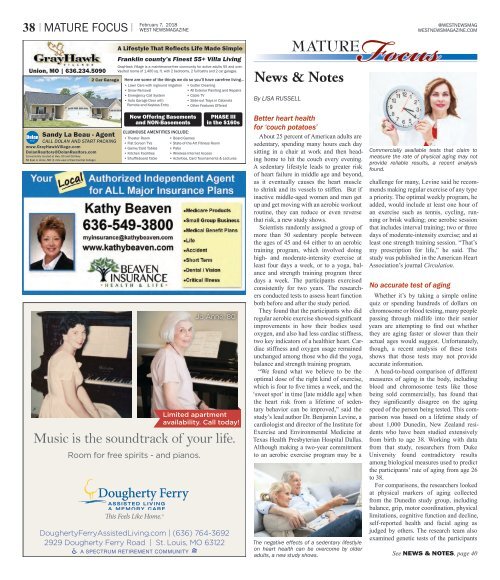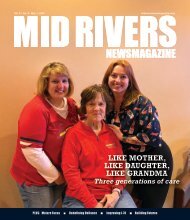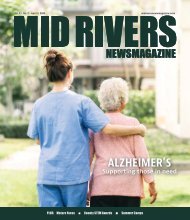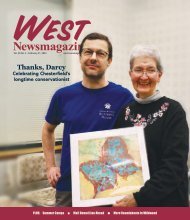West Newsmagazine 2-7-18
Local news, local politics and community events for West St. Louis County Missouri.
Local news, local politics and community events for West St. Louis County Missouri.
Create successful ePaper yourself
Turn your PDF publications into a flip-book with our unique Google optimized e-Paper software.
38 I MATURE FOCUS I<br />
February 7, 20<strong>18</strong><br />
WEST NEWSMAGAZINE<br />
@WESTNEWSMAG<br />
WESTNEWSMAGAZINE.COM<br />
A Lifestyle That Reflects Life Made Simple<br />
Franklin county’s Finest 55+ Villa Living<br />
Union, MO | 636.234.5090<br />
2 Car Garage<br />
GrayHawk Village is a maintenance-free community for active adults 55 and over.<br />
Vaulted rooms of 1,400 sq. ft. with 2 bedrooms, 2 full baths and 2 car garages.<br />
Here are some of the things we do so you’ll have carefree living...<br />
• Lawn Care with inground irrigation<br />
• Snow Removal<br />
• Emergency Call System<br />
• Auto Garage Door with<br />
Remote and Keyless Entry<br />
• Gutter Cleaning<br />
• All Exterior Painting and Repairs<br />
• Cable TV<br />
• Slide-out Trays in Cabinets<br />
• Other Features Offered<br />
News & Notes<br />
By LISA RUSSELL<br />
090<br />
A Lifestyle That Reflects<br />
Life Made Simple<br />
Sandy La Beau - Agent<br />
CALL DOLAN AND START PACKING<br />
www.GrayHawkVillage.com<br />
DolanRealtors@DolanRealtors.com<br />
Conveniently located at Hwy. 50 and Old Hwy.<br />
50 East in Union, MO (1 mile east of East Central College)<br />
DoughertyFerryAssistedLiving.com | (636) 764-3692<br />
2929 Dougherty Ferry Road | St. Louis, MO 63122<br />
DF <strong>West</strong> News 2 7 <strong>18</strong><br />
Now Offering Basements<br />
and NON-Basements<br />
CLUBHOUSE AMENTITIES INCLUDE:<br />
• Theater Room<br />
• Flat Screen TVs<br />
• Game/Card Tables<br />
• Kitchen Facilities<br />
• Shuffleboard Table<br />
A SPECTRUM RETIREMENT COMMUNITY<br />
Jo Anne, 80<br />
Music is the soundtrack of your life.<br />
Room for free spirits - and pianos.<br />
This Feels Like Home.®<br />
PHASE III<br />
in the $160s<br />
• Board Games<br />
• State-of-the-Art Fitness Room<br />
• Patio<br />
• Wireless Internet Access<br />
• Activities, Card Tournaments & Lectures<br />
Limited apartment<br />
availability. Call today!<br />
Better heart health<br />
for ‘couch potatoes’<br />
About 25 percent of American adults are<br />
sedentary, spending many hours each day<br />
sitting in a chair at work and then heading<br />
home to hit the couch every evening.<br />
A sedentary lifestyle leads to greater risk<br />
of heart failure in middle age and beyond,<br />
as it eventually causes the heart muscle<br />
to shrink and its vessels to stiffen. But if<br />
inactive middle-aged women and men get<br />
up and get moving with an aerobic workout<br />
routine, they can reduce or even reverse<br />
that risk, a new study shows.<br />
Scientists randomly assigned a group of<br />
more than 50 sedentary people between<br />
the ages of 45 and 64 either to an aerobic<br />
training program, which involved doing<br />
high- and moderate-intensity exercise at<br />
least four days a week, or to a yoga, balance<br />
and strength training program three<br />
days a week. The participants exercised<br />
consistently for two years. The researchers<br />
conducted tests to assess heart function<br />
both before and after the study period.<br />
They found that the participants who did<br />
regular aerobic exercise showed significant<br />
improvements in how their bodies used<br />
oxygen, and also had less cardiac stiffness,<br />
two key indicators of a healthier heart. Cardiac<br />
stiffness and oxygen usage remained<br />
unchanged among those who did the yoga,<br />
balance and strength training program.<br />
“We found what we believe to be the<br />
optimal dose of the right kind of exercise,<br />
which is four to five times a week, and the<br />
‘sweet spot’ in time [late middle age] when<br />
the heart risk from a lifetime of sedentary<br />
behavior can be improved,” said the<br />
study’s lead author Dr. Benjamin Levine, a<br />
cardiologist and director of the Institute for<br />
Exercise and Environmental Medicine at<br />
Texas Health Presbyterian Hospital Dallas.<br />
Although making a two-year commitment<br />
to an aerobic exercise program may be a<br />
The negative effects of a sedentary lifestlyle<br />
on heart health can be overcome by older<br />
adults, a new study shows.<br />
Commercially available tests that claim to<br />
measure the rate of physical aging may not<br />
provide reliable results, a recent analysis<br />
found.<br />
challenge for many, Levine said he recommends<br />
making regular exercise of any type<br />
a priority. The optimal weekly program, he<br />
added, would include at least one hour of<br />
an exercise such as tennis, cycling, running<br />
or brisk walking; one aerobic session<br />
that includes interval training; two or three<br />
days of moderate-intensity exercise; and at<br />
least one strength training session. “That’s<br />
my prescription for life,” he said. The<br />
study was published in the American Heart<br />
Association’s journal Circulation.<br />
No accurate test of aging<br />
Whether it’s by taking a simple online<br />
quiz or spending hundreds of dollars on<br />
chromosome or blood testing, many people<br />
passing through midlife into their senior<br />
years are attempting to find out whether<br />
they are aging faster or slower than their<br />
actual ages would suggest. Unfortunately,<br />
though, a recent analysis of these tests<br />
shows that those tests may not provide<br />
accurate information.<br />
A head-to-head comparison of different<br />
measures of aging in the body, including<br />
blood and chromosome tests like those<br />
being sold commercially, has found that<br />
they significantly disagree on the aging<br />
speed of the person being tested. This comparison<br />
was based on a lifetime study of<br />
about 1,000 Dunedin, New Zealand residents<br />
who have been studied extensively<br />
from birth to age 38. Working with data<br />
from that study, researchers from Duke<br />
University found contradictory results<br />
among biological measures used to predict<br />
the participants’ rate of aging from age 26<br />
to 38.<br />
For comparisons, the researchers looked<br />
at physical markers of aging collected<br />
from the Dunedin study group, including<br />
balance, grip, motor coordination, physical<br />
limitations, cognitive function and decline,<br />
self-reported health and facial aging as<br />
judged by others. The research team also<br />
examined genetic tests of the participants<br />
See NEWS & NOTES, page 40

















